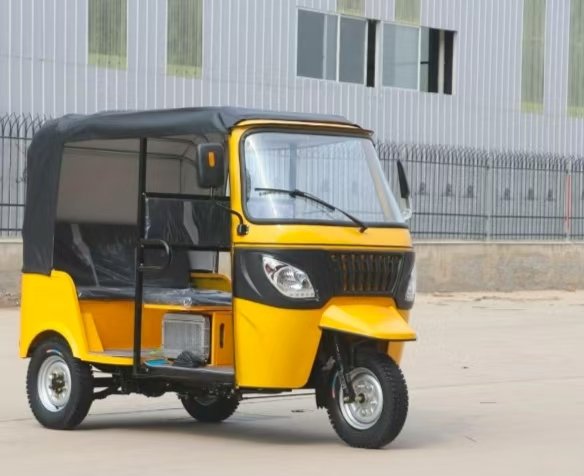
Once a common sight weaving through streets and alleys, the human-powered tricycle carries countless people’s memories and the course of urban development, boasting a product story filled with charm and significance.
Its origin dates back to the late 19th and early 20th centuries. At that time, as cities expanded and populations grew, the demand for convenient, flexible short-distance transportation became increasingly urgent. Against this backdrop, the human-powered tricycle emerged. It first appeared on the streets of major cities such as Shanghai and Guangzhou. In 1873, a French merchant named 米拉 (Mila) established a hand-pulled cart passenger service in Shanghai, and later introduced rickshaws from Japan—these were the early prototypes of human-powered tricycles. Initially, these rickshaws had wooden wheels covered with iron sheets, making rides quite bumpy. Later, they were gradually improved with wire-spoke rubber wheels, resulting in much smoother rides and easier pulling. Thanks to its advantages of no fuel consumption, convenience and affordability, the rickshaw became popular quickly after its launch. By 1914, there were 9,178 rickshaws alone in the Shanghai International Settlement. At that time, to distinguish public rickshaws from private hired rickshaws, the relevant authorities of the concession stipulated that public rickshaws must be painted yellow—hence the name “yellow rickshaw” (Huangbaoche).
The design of early human-powered tricycles was relatively simple. The body was mainly made of wood or metal, with a simple yet sturdy and durable structure. The front part was equipped with handlebars, a bell, brakes, and pedals for the rickshaw puller to step on, which drove the rear wheels via a chain. The carriage was usually a wooden semicircle that could seat two people side by side. Although it had no excessive decorations, it basically met passengers’ riding needs. The puller sat at the front and provided power by pedaling with both feet to move the carriage forward. This design allowed the human-powered tricycle to maneuver nimbly through narrow streets and alleys, greatly facilitating people’s travel.
Over time, the design of human-powered tricycles has also undergone improvements and innovations. In terms of comfort, the seats inside the carriage gradually adopted softer materials such as sponge, and the shape of the seats was optimized to be more ergonomic, reducing passengers’ fatigue during long rides. Meanwhile, to cope with different weather conditions, some human-powered tricycles began to be equipped with foldable or detachable canopies, which could provide shade from the sun and shelter from the rain. In terms of safety, the braking system was further improved—upgraded from the initially simple brake device to a more sensitive and reliable one, ensuring timely stopping during travel. Some human-powered tricycles also added safety features such as reflective markers to improve visibility at night or in low-light environments. In addition, there were changes in appearance design: some tricycles began to have simple patterns or decorations painted on the body, making them more aesthetically pleasing.
Human-powered tricycles have a wide range of application scenarios and once played an important role in urban transportation. In the past, they were one of the preferred means of short-distance travel for urban residents. Whether in bustling commercial districts, where people needed to move quickly between different stores, or in residential areas, where residents went shopping at nearby vegetable markets or shops, human-powered tricycles, with their small and flexible bodies, could easily navigate through narrow streets, avoid traffic jams, and save travel time. For people with limited mobility or those prone to motion sickness, the stable and slow riding style of human-powered tricycles also provided a comfortable travel option. In the field of tourism, human-powered tricycles also played a unique role. In some historical and cultural cities or characteristic tourist attractions, tourists taking human-powered tricycles can experience the local customs and traditions more closely, enjoy the city’s beautiful scenery along the way, and stop to take photos at any time. With their familiarity with the local area, rickshaw pullers can also introduce the historical culture and stories behind the attractions to tourists, allowing them to gain a richer travel experience. For example, around West Lake in Hangzhou, there are many human-powered tricycles providing lake-circling tour services, enabling tourists to appreciate the beauty of West Lake and the charm of Hangzhou in a unique way. In terms of cargo transportation, although the load capacity of human-powered tricycles is relatively limited, they still have advantages for transporting small goods or short-distance transportation in narrow alleys. Some small vendors use human-powered tricycles to transport goods for their daily business operations.
In the market, human-powered tricycles were once very popular. For ordinary consumers, they were affordable—especially in the era when public transportation was underdeveloped, human-powered tricycles provided an economical and practical travel option. For rickshaw pullers, this was an important means of making a living. Many people relied on pulling tricycles to support themselves and their families. In some cities, human-powered tricycles even formed a large industry, creating a large number of job opportunities around links such as production, sales, and maintenance. However, with the development of the times and advances in technology, urban transportation methods have become increasingly diversified. Modern means of transportation such as cars, buses, and subways have gradually become popular, greatly impacting the market share of human-powered tricycles. In some large cities, due to considerations such as traffic congestion and environmental protection, the government has restricted or banned the operation of human-powered tricycles. Nevertheless, in some medium and small-sized cities or specific tourist areas, human-powered tricycles still retain a certain market share. With their unique charm, they continue to provide services and have become a unique scenic spot in the city.
